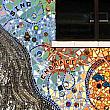More About John Douglas Powers, 7th place
Description of work: Field of Reeds is a kinetic sculpture measuring approximately 4 1/2 feet in height by 14 feet by 10 feet. It is composed of 1001 vertical “reeds” held in place and supported by an articulated wooden assemblage connected to an electric motor via a series of offset cams. The wooden elements are gilded to reference the 1001 Kannon figures of Sanjusangendo, and when power is run to the sculpture the reeds or stalks of wheat sway back and forth. The repetitive, poetic motion of the piece combined with the subtle rustle of reed against reed alludes to a meditative or virtual space similarly to the historical and cultural influences of the piece.
Work statement: The art historical touchstone for Field of Reeds is Sanjusangendo, a temple in Kyoto, Japan that houses 1001 human-scale gilt wooden sculptures of Kannon, the Japanese spirit of compassion. A second historical influence comes from the ancient Egyptian mythological belief system regarding death. In this set of myths there exists Sekhet-Hetepet (Fields of Reeds). The souls of the deceased must overcome several obstacles in their journey through the underworld and finally encounter Anubis who weighs the soul against the feather of Ma’at. Righteous individuals were allowed to join the afterlife and each was granted a plot in the Field of Reeds. Sound and motion are used to address the elusiveness, the transcendent qualities of these disparate beliefs. The ominous squeak of wood on steel is in counterpoint to the soothing, poetic swaying of the reeds—a tense coexistence mirroring that between life and death, creation and destruction.
Art form: 3-D
Medium: Wood, steel, plastic and electric motor
Year created: 2008

 facebook
facebook





